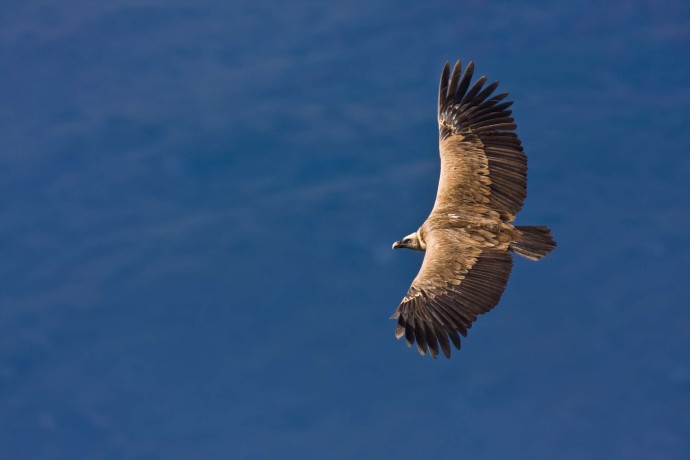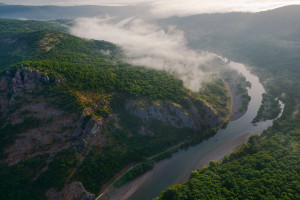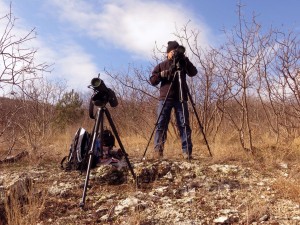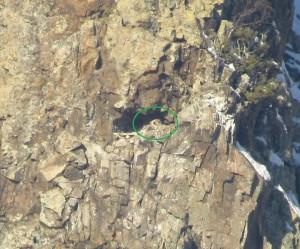Volen Arkumarev, a conservation officer with the Bulgarian Society for the Protection of Birds (BSPB), is working on the LIFE Vultures project. He recounts a record breaking griffon vulture monitoring session in the Rhodope Mountains.

It’s a cold morning and the Arda river is flowing through the rocky hills in its calmness. Below the deep blue sky a silver line on the eastern horizon hints at the approach of a fine day. We need neither alarm nor coffee because excitement has kept us awake the night before – it’s time for the regular monitoring of griffon vultures in the Eastern Rhodopes. This is the moment where we discover whether our efforts to protect this beautiful species over the previous year are starting to pay off.

The griffon vulture was brought to the brink of extinction in Bulgaria in the early 1970s. Once common throughout the country, human activities such as poisoning and poaching had a devastating impact on its population and range. Only a single pair and a few vultures were found in 1978 near Studen Kladenets. A few years later, another colony of 3 pairs and 20 birds was found near the town of Madzharovo.
Shortly after sunrise, we are travelling towards the first breeding cliff, armed with binoculars, spotting scopes, notebooks and a lot of excitement. The massive volcanic cliff, situated on the north bank of Arda river, soars upward for 200 meters, from the clean river waters to the clear blue skies. Called Kovankaya, this expanse of rock is home to almost 25% of the griffon vulture population.
We thoroughly check every possible ledge for incubating birds, congratulating each other for every new nest found. The task is not an easy one. When you consider that griffon vultures have the same colour as the cliffs, it becomes more like a game – who will find the hidden object on the picture.
The cliff, a volcanic remnant, offers the perfect breeding environment for griffon vultures, with numerous ledges perfect for nests. In one such nest we spot an old friend – this is the vulture called “Storm” who we tagged last year with a satellite transmitter. We had suspected that it had already started breeding, with data from the last week showing almost no movement and a strong attachment to a specific part of the cliff.

We recognize Storm by her blue wingtag and green ring. She is taking care of her only egg, which will be her top priority over the next few months. She and her partner have chosen a nice ledge with a warm southerly exposition and gorgeous view towards the meandering river. It is a nest used by this pair for a few years now – the previous season they successfully raised a healthy chick here.
The sun is now high in the sky and no hats or gloves are needed. The snow is slowly melting and we continue on the road, following the serpentine Arda to the west. With every new cliff a new challenge, the number of vulture pairs discovered continues to increase. We have already reached 40, but this is still less than we are hoping for.
Intensifying thermals lift vultures in gorgeous flight high into the Rhodopean skies. Just above our heads they fly, using their 2.7-metre wingspan to gain height, before gliding effortlessly in small groups in different directions. Small vulture groups typically cover a huge territory, keeping an eye on neighbouring groups as they form an aerial communication network. With the whole colony working as one, this highly effective system allows the vultures to spot any dead animal and carry out their important work of keeping nature clean.
That afternoon, tracking another tagged griffon vulture called Vihar, we find its nest on a cliff which has never been occupied by vultures before. Thanks to the transmitter, we discover the bird and his mate breeding on a nice warm cliff near Studen Kladenets reservoir.
After tagging, Vihar spent four months in northern Greece and we thought he might start breeding there. But in early winter he returned to Bulgaria, roosting together with other vultures at this well-used site. Two months later and he has built a new nest and his mate is incubating! What an amazing observation. Thanks to our ongoing efforts, we now know much more about vulture behavior and ecology, helping us to successfully apply conservation measures and protect these stunning birds.
Studen Kladenets reservoir is the biggest in the area and all vultures from this colony are breeding on steep inaccessible slopes above the water. We are forced to use a boat and sail across the deep waters to reach observation points. Sailing in February is not always a pleasure, especially when it’s windy, but luckily none of us suffer from seasickness and we reach the reservoir’s opposite shore in double quick time.

The number of vultures in the sky is increasing, as is the number of the discovered nests. We soon reach another milestone – 60 occupied nests! Some of the birds are incubating, but others are still busy bringing grass and sticks to the nest and arranging it with great care, like a young couple refurbishing their new apartment.
One of the late breeders turns out to be a third tagged vulture, called Krum. At 15, he is the oldest of the trio. Krum likes to spend his time near the nest and observe the whole area from the top of the cliff. One might think that if you have wings you can easily go wherever you want, but the only place Krum wants to be, day after day, is his home cliff. He is quite attached to his nest, and is quite busy making last minute changes before incubation.
We have no time to lose. The sky to the west is turning red, but we have one more cliff to check. The boat fairly flies to the next viewpoint, with startled ducks and pelicans taking to the air. We reach it right on time, with the warm, late afternoon light perfect for checking each ledge for more incubating vultures. One is here…. another there behind the bush…. I see a wing in nest number 24…. one more on the ledge behind…… all in all, we find 23 nests! An amazing result, this is the highest number ever recorded on this cliff. We are all deeply satisfied after our long day’s work.
Our monitoring session of breeding griffon vultures in the Rhodope Mountains reveals a total of 86 occupied nests. This represents six more pairs than last year, and a remarkable 20% increase over the last three years.
Tomorrow is a new day. New challenges await, but hopefully it will be a day with a brighter future for griffon vultures – these magnificent lords of the Rhodopean sky!
 Find out more about the EU funded LIFE project “Conservation of black and griffon vultures in the Rhodope mountains” here. This project has been developed by Rewilding Europe, in partnership with the Rewilding Rhodopes Foundation, Bulgarian Society for Protection the birds, WWF Greece, Hellenic Ornithological Society and Vulture Conservation Foundation.
Find out more about the EU funded LIFE project “Conservation of black and griffon vultures in the Rhodope mountains” here. This project has been developed by Rewilding Europe, in partnership with the Rewilding Rhodopes Foundation, Bulgarian Society for Protection the birds, WWF Greece, Hellenic Ornithological Society and Vulture Conservation Foundation.
